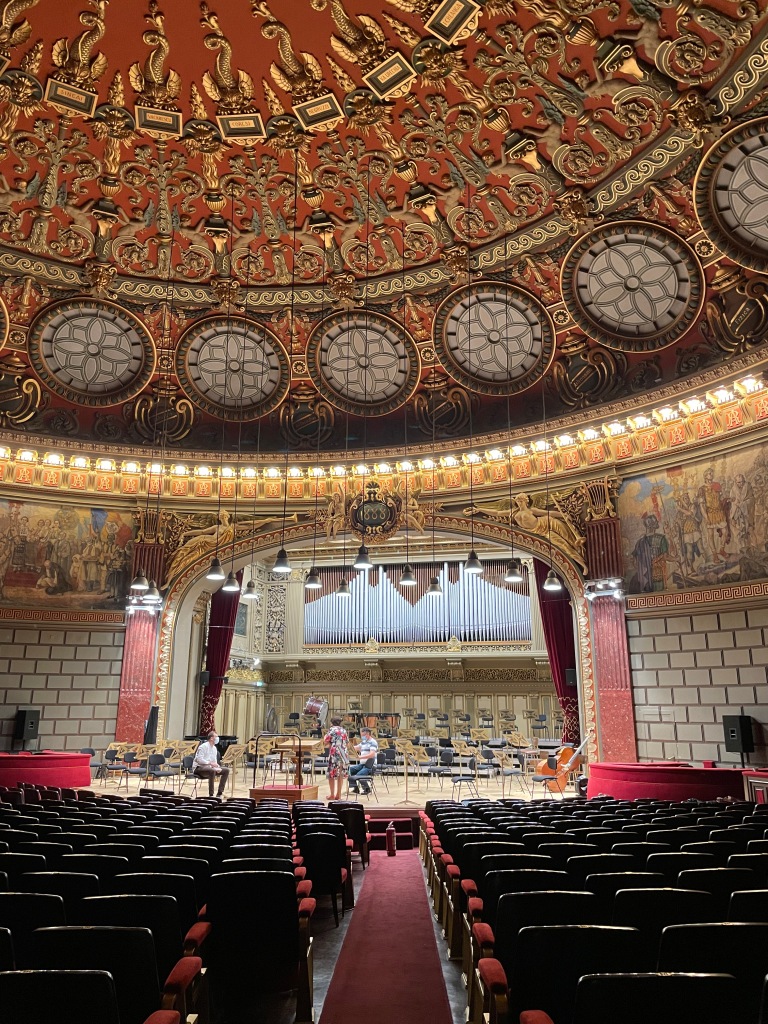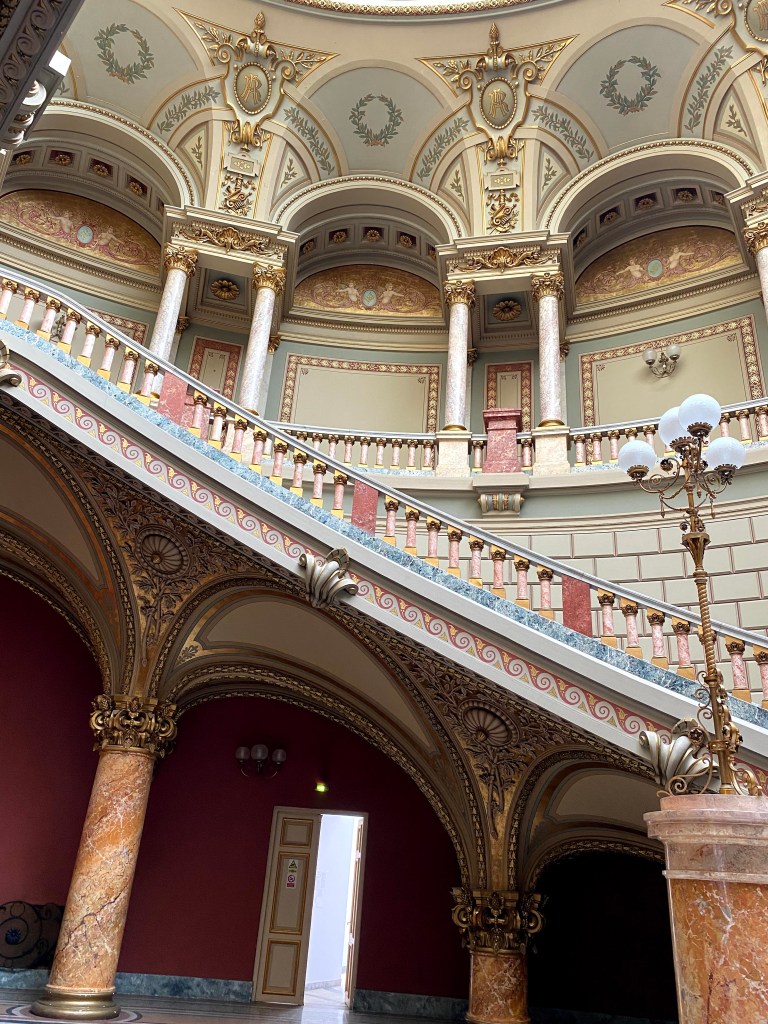I love to travel, and I confess, I fall in love with almost every place I visit. Many times, I’ve convinced myself that, oh, yes, I could live here happily ever after. Reality does eventually set in, of course. The afterglow fades…leaving behind pleasant memories and, hopefully, a change in my heart and perspective; expanded horizons.
I tell you this about me, because you should realize that I am freshly home from my last adventure and still wallowing in the warmth of a thoroughly delightful experience. I want to write it all down before the afterglow fades, because that feeling — that’s one of the main reasons we travel, right? Hope you enjoy…
In February, I booked a small group tour to a country that has never been on my “must see” list. I had nothing against it – it just wasn’t even on my radar. But, thanks to a year of stifled wanderlust, I was ready – ready to travel just about anywhere! I came across this tour and it snagged me. The itinerary was compelling, the group size was appealing and I had read a few reviews that helped push me over the edge. So, having convinced my friend to join me, I took the gamble – Would we be able to travel by August? Would it be safe? Would I lose my deposit? – and booked the tour.
Who knew (maybe me, seeing as I have a penchant for it) that a country I was so unfamiliar with would capture my heart like it did?! Romania…utterly surprising and completely unforgettable.
Over the course of 12 days we visited 3 unique locations – spending several days in each – learning about the history, culture, environment and people of this beautiful eastern European country. Our pace was unhurried but each day was chock-full of delights. I had to take notes because we were learning so much every day!
Bucharest
I’ll start at the beginning. We landed in Bucharest, the capital of Romania, on a Sunday afternoon. It was hot and sunny. The climate in Romania isn’t so different from my home state of Michigan – four seasons, hot summers, cold winters. As we rode into the city (airport transfers included with the tour), we noticed that it looked kind of like we were driving into Detroit: a mix of tall and squatty buildings – from old and worn to shiny and new, a fair amount of traffic, and graffiti – quite a lot of graffiti, actually.
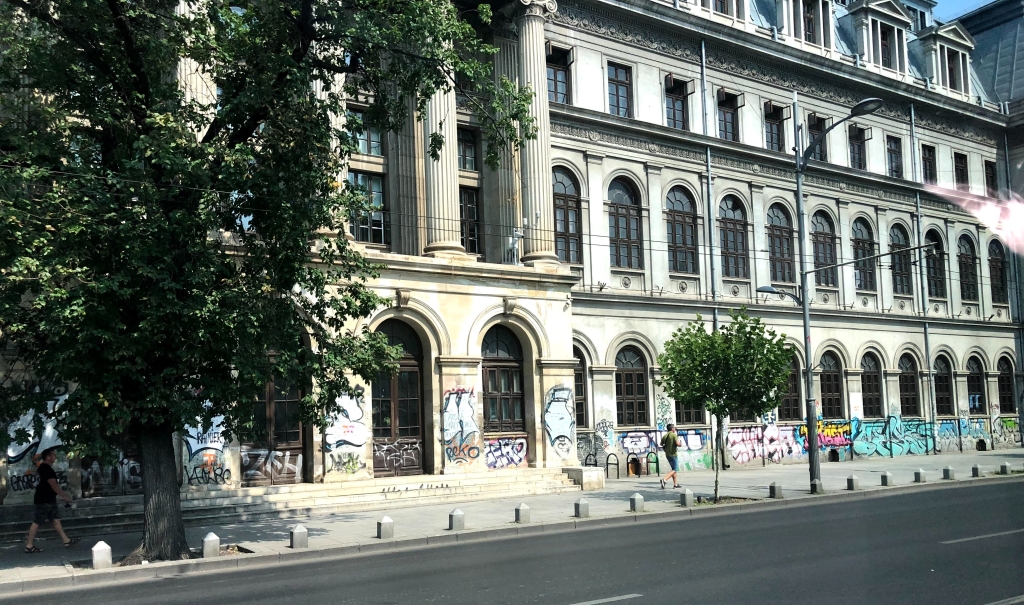
Stefan, a Bucharest native and our guide, took us on a walking tour of the city on our first day. Bucharest is a lively city on a Monday morning – a fair amount of car and pedestrian traffic. It gave the impression it is a working city – filled with locals going about their business with tourists like us just sprinkled in. As we walked, Stefan gave us a little history lesson.
Romania became part of the Soviet Bloc after WWII and remained under communist rule until 1989, although it had gained some independence from the Soviet Union in the late 1950s. Stefan told us about his experience as a child during the revolution against Communism, which occurred in December of 1989. He recounted how, when he returned to school in January, all of his school books had had pages torn out of them – the pages that proclaimed and acknowledged the communist rule in Romania. Fortunately, he was young, and news didn’t travel quite so quickly then as it does today. Stefan was blissfully ignorant of the details of that brief, violent revolution that ended in the overthrow and Christmas Day execution of Romanian leader, Nicolae Ceaușescu, and his wife.
Despite the citizens’ efforts to erase communism, Bucharest is full of reminders: Communist-era apartment blocks, colossal buildings erected at great expense while Romanians were struggling to feed their families, beautiful churches that were moved – yes, moved – out of the public eye, by order of Ceaușescu. An engineer, Eugen Iordachescu, actually developed a technique to move entire buildings without damaging them. He was responsible for saving dozens of churches in this manner.
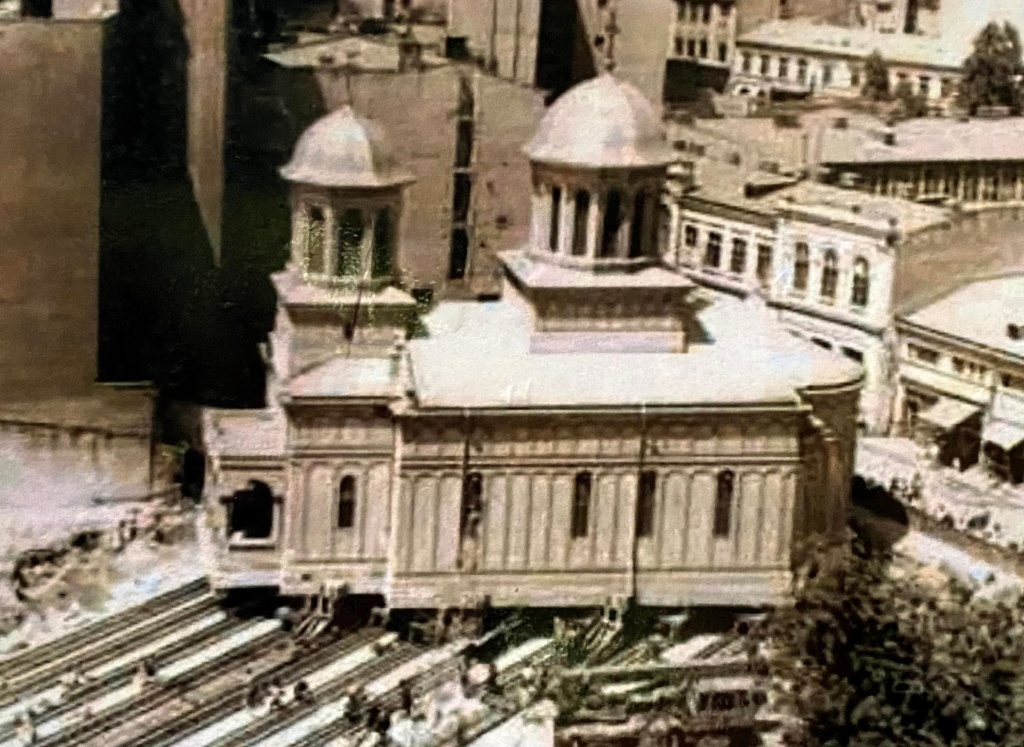
While communism certainly left its mark on Bucharest, so did many other cultures, religions and artists. As I mentioned, we saw a lot of graffiti around the city. We asked about it and found out that the graffiti is a point of pride for Bucharest residents. It isn’t gang-related like so much of the graffiti found in the US. Instead, it represents the voices of those who had been oppressed for decades, finally able to speak freely and express themselves. In fact, despite some city leaders wanting to clean up the graffiti, the residents insisted that it be left alone.
We saw things much differently after hearing that story.
The architecture is quite varied in Bucharest – from medieval to modern. We saw Roman architecture, Byzantine-style and many buildings that would have looked at home in the center of Paris! One of my favorite buildings is this one – the Union of Romanian Architects HQ.

Its design is quite controversial. The original building was destroyed in 1989 by a fire. The architects chose to use the remains of the original building for the new project. I find it to be a very apropos symbol for this eclectic city with its complex history and resilient spirit.
Another memorable stop was the Atheneum. It is a gorgeous concert hall, proudly constructed using private donations from Romanian folks – definitely not funded by the government. We were fortunate to catch the beginnings of a rehearsal of the philharmonic for an upcoming George Enescu festival!
Bucharest is quite a walkable city. There are many pedestrian-only streets tucked away from the noisy thoroughfares, especially in the old town section of the city. The art and monuments scattered around the city are well worth seeking out. I do recommend that you engage a local guide who can fill you in on the significance of the things you will see. It makes all the difference! Oh, and take a couple hours to wander through the National Museum of Art. We found it to be uncrowded, and it housed some nice surprises by Renoir, Monet and other world famous artists. The museum itself is gorgeous!

We enjoyed several meals at local restaurants while in Bucharest – especially enjoying the traditional dessert – papanasi – a warm cheese donut covered in crème fraîche and berries! Traditional cuisine reminded me a bit of German food – though, rather than potatoes, we were often served polenta. We were treated to some traditional dancing in an old beer hall – Caru cu Bere – so much fun!

Onward to Transylvania
On Day 3 we climbed aboard our minibus. We headed out of the city and toward the Prahova Valley, Carpathian Mountains and Transylvania. No tour of a European country would be complete without a visit to a castle, right? We were treated to two during our tour, the first was Peles Castle in Sinaia.
We were dropped off at the restaurant/gathering area at the entrance to the castle grounds, where we could catch just a glimpse of the castle through the trees. We enjoyed a little lunch and purchased some fresh berries from a local Roma woman while we waited for our chance to visit the castle. Those berries were so delicious – fresh-picked, for sure!

A short walk put us squarely in front of this beautiful castle, built between 1873 and 1914, in the neo-renaissance style, by King Carol I. Stefan, again, was our guide here. He regaled us with all kinds of history and details about the beloved king and his castle. We enjoyed our private guided tour and were also able to wander the grounds on our own for a bit. It was a visual feast, the ornate Peles Castle nestled among the trees in this verdant valley – well worth the visit.
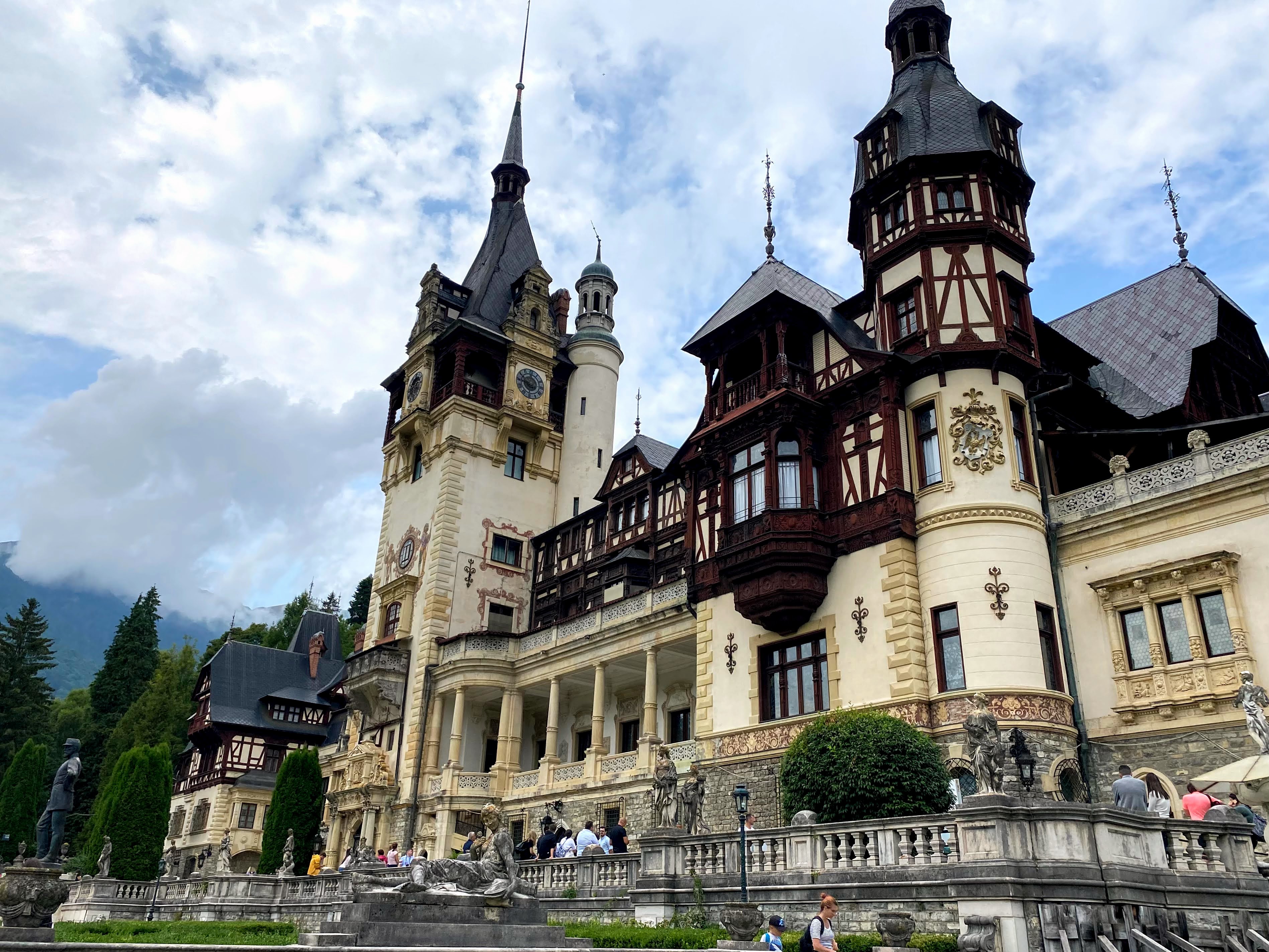
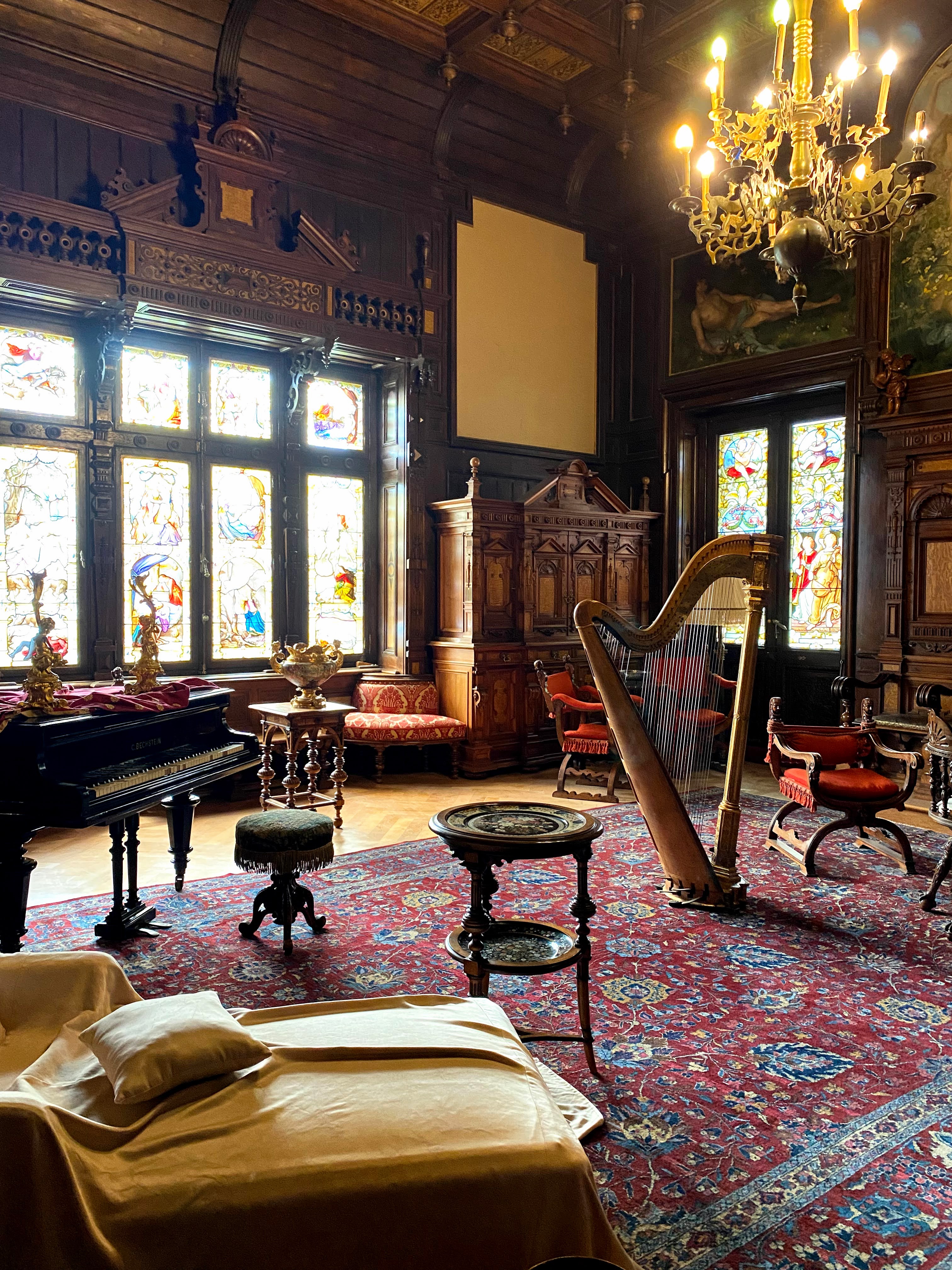
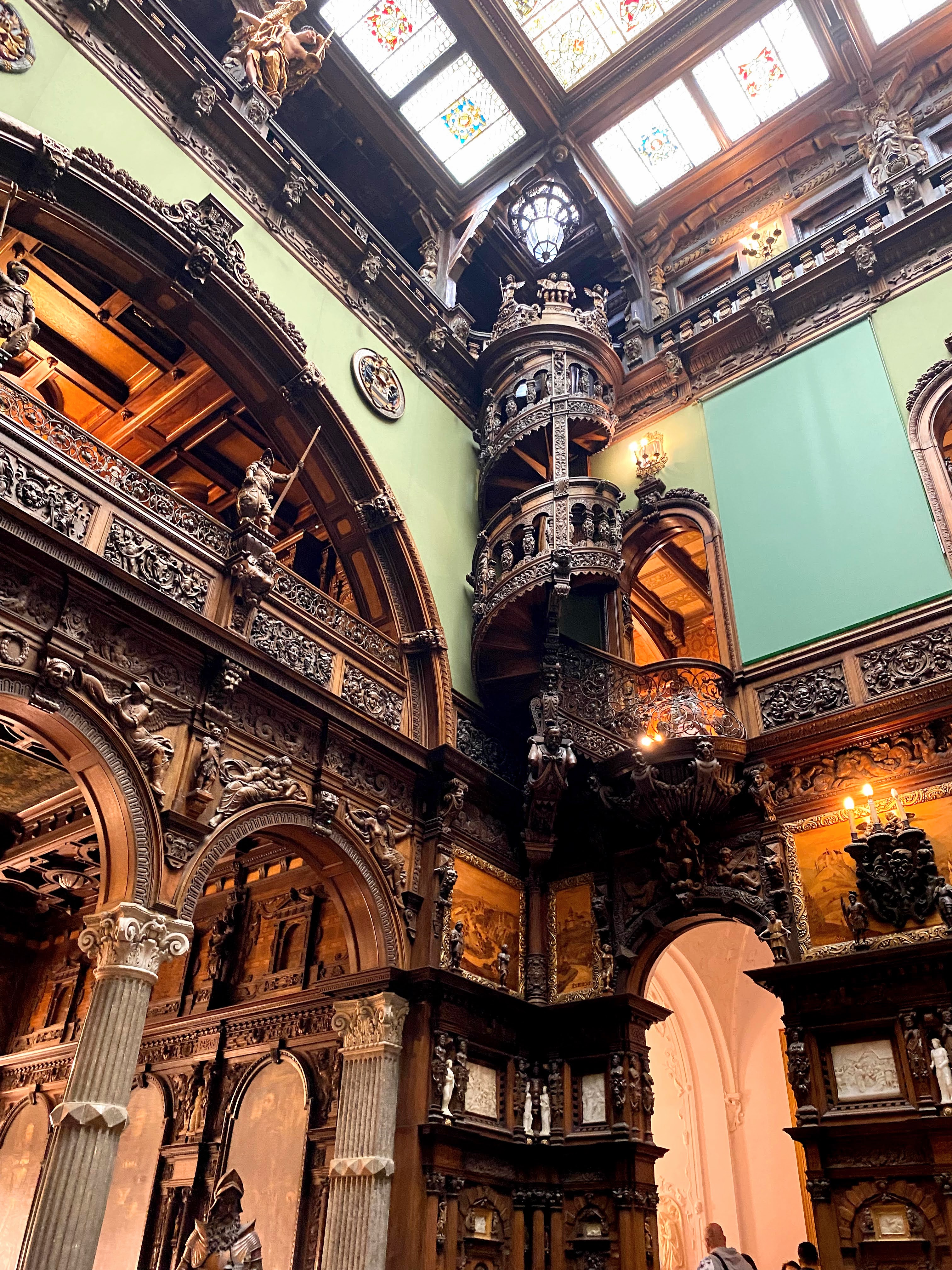
We said goodbye to Stefan here, as he headed back to the city and we moved on to the medieval city of Brasov.
Brasov
Brasov is one of the most visited places in Romania. It is located in the center of the country, snuggled into a valley of the southern Carpathian Mountains. Originally settled by Saxons, Brasov is situated at the intersection of old trade routes linking the Ottoman Empire and western Europe. Brasov was a fortified city, with each tower maintained by a different craft guild. Each guild would then be called to defend their tower, as was custom during those times, and allowed the city to be defended without maintaining a full time army.
We spent most of that first day in Old Town – the Saxon part of the city. Here, again, we were accompanied by a local guide. Anne is of Saxon descent, and well-versed in her city’s story. She filled our heads with all sorts of facts and interesting tales. Anne introduced us to the city’s history and varied architecture as well as its current attractions – including artisanal chocolate and coffee shops and a traditional Romanian bakery! We visited the Black Church, a Gothic-style Lutheran cathedral that dates back to the 15th century. Originally a Catholic church, it was adapted to the more austere Lutheran religion as a result of the Reformation, a non-violent religious transition that occured in 1542. The church, along with much of the historical city, was partially destroyed in a fire in 1689. The church gained its nickname, The Black Church, as a result of the damage it sustained in the fire.


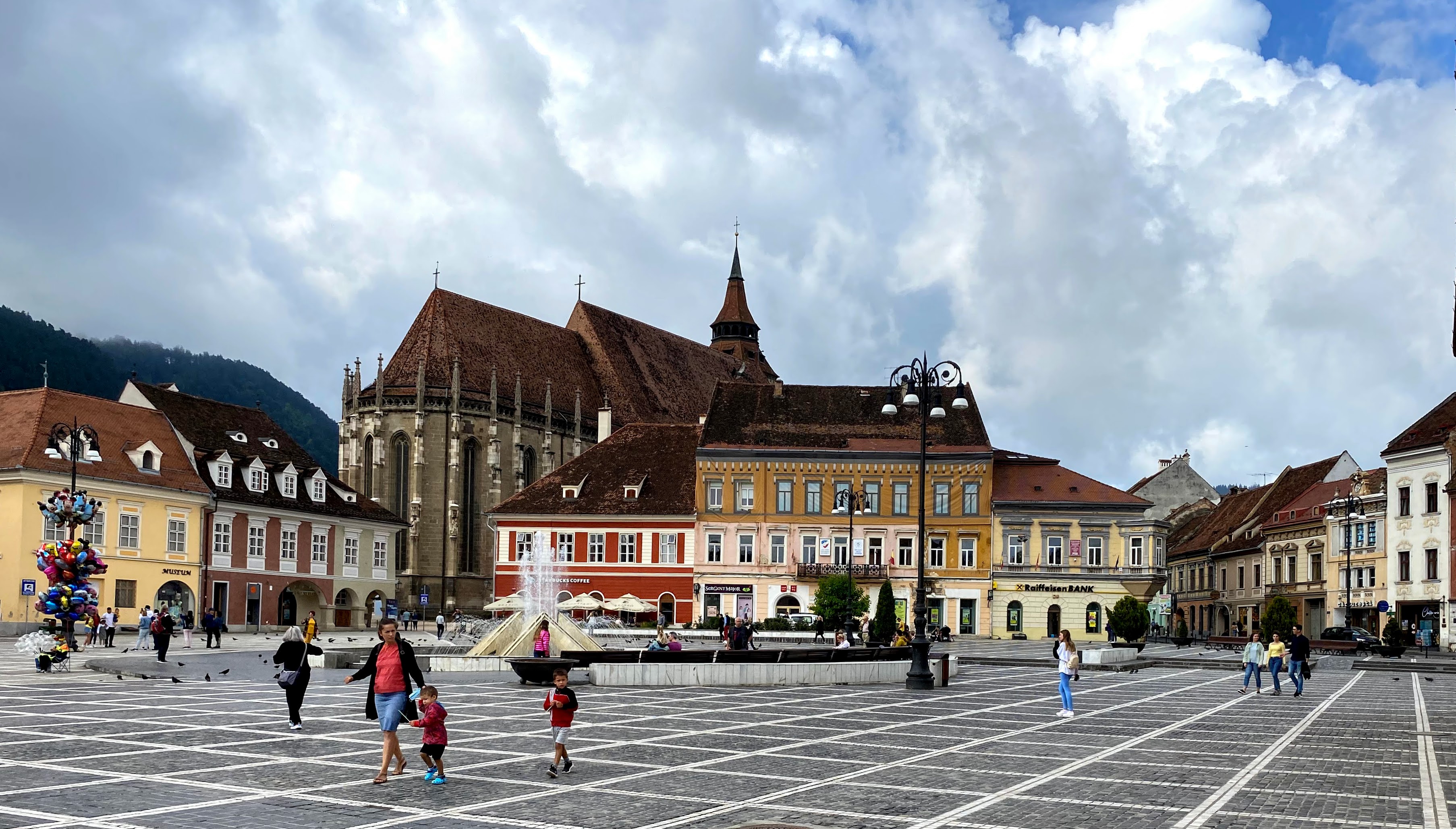
We had plentiful opportunities during our three-day stay at the Aro Palace Hotel (a mid-century-style delight!) to stroll along the cobbled pedestrian streets of Brasov. The Piata Sfatului is the main square that fills with outdoor restaurant seating in the evening and provides endless entertainment – food and drink, shopping and people-watching.
Anne accompanied us to the workshop of a traditional wood painting artist, Marga Armanko. There, Marga tutored us in this art. Some of us took to it – others did not (that would be me!). Regardless, it was a treat to be introduced to this art by someone who took such pride in it. We were able to carry our “masterpieces” home as a souvenir of that experience. That evening we had dinner at the charming Bistro del Arte, where we were entertained by a pianist while we enjoyed a delicious meal.
Bran Castle
We ventured out early the next morning in order to beat the crowds at Bran Castle. Anne joined us as our guide on this day as well. She explained that Bran Castle, dating back to the 13th century, may have been visited by Vlad the Impaler (yes, a very tenuous connection!). You may recognize this king as the inspiration for Bram Stoker’s Dracula. Did you know that Bram Stoker had never been to Romania when he wrote his novel? He had only heard stories of Vlad the Impaler. He combined some of those details with his own experiences to create the story of Dracula. It is widely believed that Bram Stoker suffered from tertiary syphilis. Whether that or something else, his condition left him bed ridden, pale and sensitive to the light. Sound familiar?
Unbeknownst to Romanians, the novel inspired people to seek out “Dracula’s Castle”. The castle’s popularity has helped to transform Bran from a sleepy town into a tourist destination. The castle was packed with people eager to see the home of Dracula. Despite its grisly associations, though, the castle is mainly a museum dedicated to displaying the art and furniture of Queen Marie.
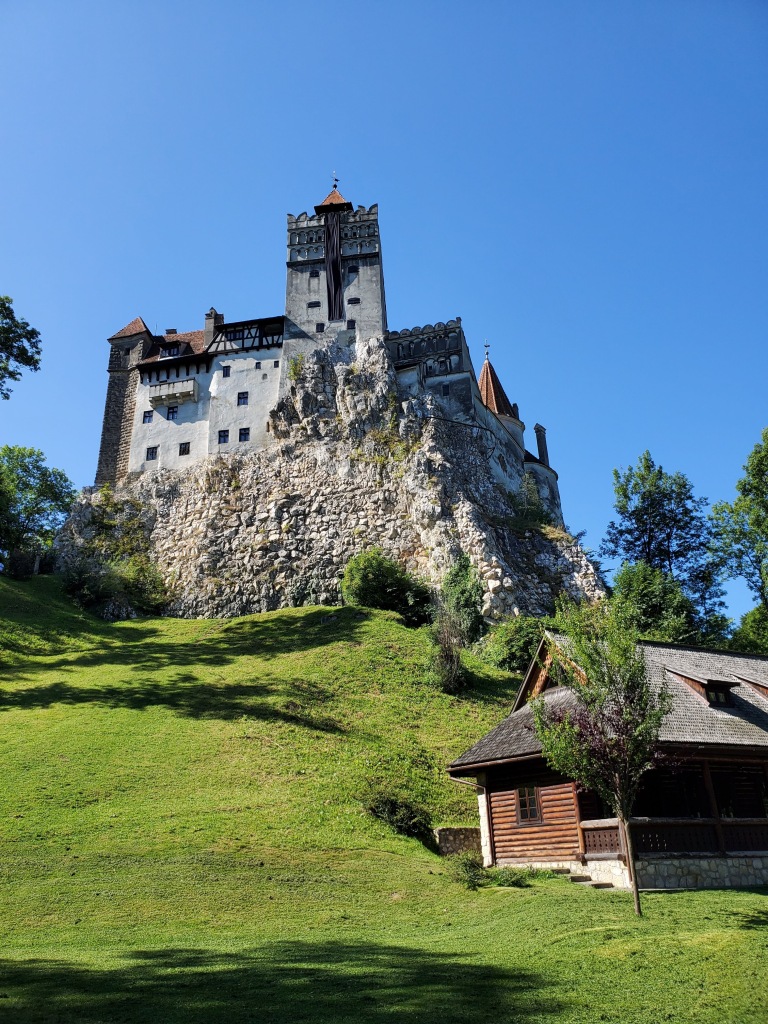
Traditional Egg Painting and Lunch at Gabriela’s Home
After a leisurely stroll around the grounds of Bran Castle and a wander through some of the decidedly kitschy craft stalls in town, we boarded the bus and headed for our next artisan experience. You see, this tour had a theme of sorts, focusing on the traditional arts of the country.
We were invited into Gabriela’s home, where she served us a lovely traditional lunch, which included a LOT of polenta – just ask our tour leader, Derek! – along with some absolutely delicious visinata (a traditional cherry liqueur) and tuica (a traditional pear liqueur). While we relaxed over our home cooked meal, Gabriela modeled her traditional costume for us. She was very proud to share her treasure, an embellished blouse made by her grandmother 150 years ago! Gabriela was delightful, no English needed, though Anne did her best to translate. Interestingly, Gabriela used several words that Anne was unable to interpret. This may have been due to regional dialects or terms specific to Gabriela’s art form. It simply added extra color to the experience.
After lunch, Gabriela demonstrated her craft – the traditional painting of eggs. She is the only one in the area who still practices this art form. Gabriela has begun to teach the local children in order to keep this tradition alive. She explained how she removes the raw egg from inside the shell using a syringe to blow air in through the single hole, pushing the yolk and white out through the same hole. Clearly this is delicate work! She allowed some of us to try our hand at drawing on the eggs with the melted wax using a special stylus. The process involves several steps that include drawing the design with wax and then dipping it into the dye, letting it dry and drawing again with wax, dipping into the dye, repeating as many times as needed. She said each egg takes about six hours to complete! The designs were intricate and oftentimes depicted traditional scenes. We were enthralled and very happy to be able to purchase all of her available works of art.



We were completely charmed by Gabriela and so impressed by her skill. She gifted each of us with an egg that also included her handwritten explanation of the design. Yes, many of us are now facebook friends with Gabriela. You can be, too: www.facebook.com/gabriela.clinciu.96.
Returning from our full day, we stopped at the top of the valley to capture the sweeping views of Brasov nestled below. Delivered safely to our hotel after this amazing day, we were left to our own devices for the evening. Several of us headed for the main square and an evening of laughter and traditional palinka (a plum brandy-style liquor).
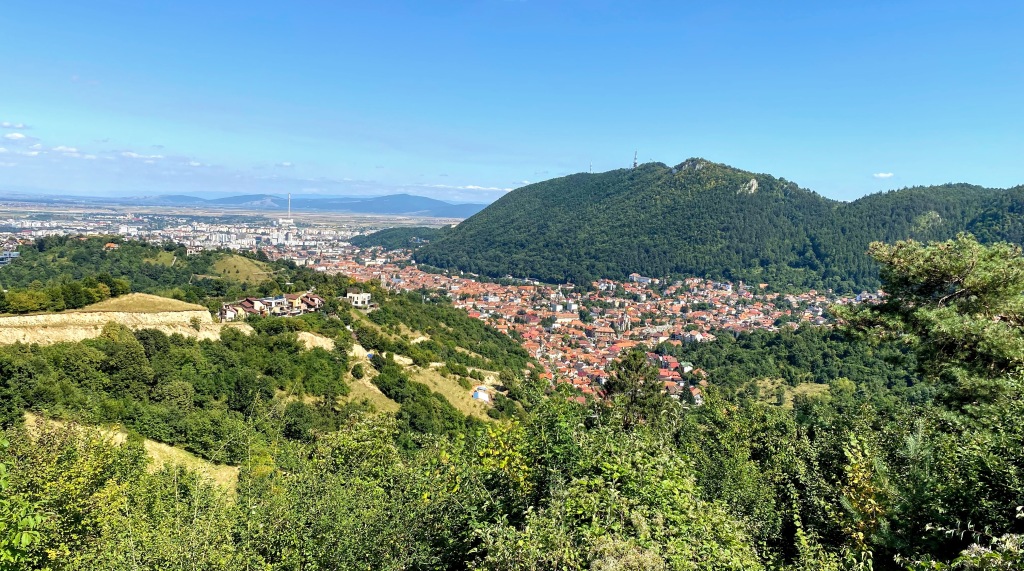
Beyond Brasov… so much more yet to come
It was time to move on from Brasov. Each day of this tour seemed to build on the last and provide unending delights. Could our experiences to this point be beat? We couldn’t imagine it. We were just past the halfway point of our tour, but, our final days were SO full that I will leave that for another post. I hope you’ll return for it – you won’t be disappointed!
I won’t stop here without acknowledging the hard work of our tour leader, Derek Baron, of Wandering Earl Tours. He crafted a perfect tour, taking into account his audience (we were all women over 50) and the environment, and making excellent use of his local sources. I can’t recommend him highly enough. Thank you to Janet Jaffe of The Women’s Travel Tribe for partnering with Wandering Earl for this tour!
